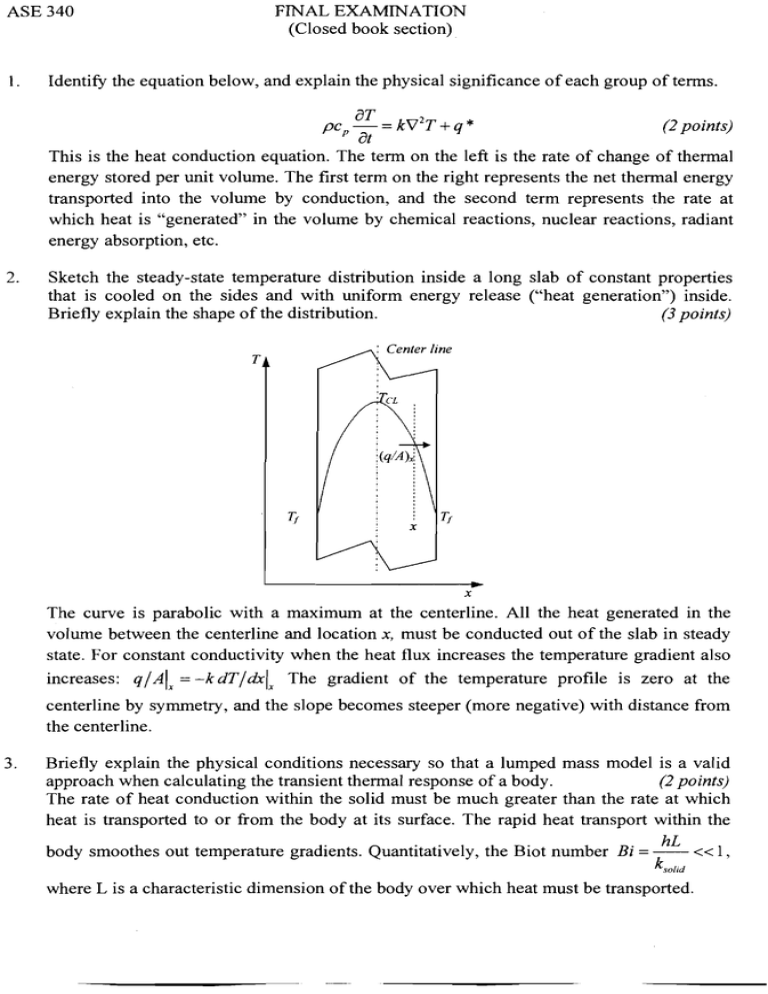ASE FINAL EXAMINATION (Closed book section)
advertisement

FINAL EXAMINATION
(Closed book section)
ASE 340
1.
Identify the equation below, and explain the physical significance of each group of terns.
(2 points)
This is the heat conduction equation. The term on the left is the rate of change of thermal
energy stored per unit volume. The first term on the right represents the net thermal energy
transported into the volume by conduction, and the second term represents the rate at
which heat is "generated" in the volume by chemical reactions, nuclear reactions, radiant
energy absorption, etc.
2.
Sketch the steady-state temperature distribution inside a long slab of constant properties
that is cooled on the sides and with uniform energy release ("heat generation") inside.
Briefly explain the shape of the distribution.
(3 points)
The curve is parabolic with a maximum at the centerline. All the heat generated in the
volume between the centerline and location x, must be conducted out of the slab in steady
state. For constant conductivity when the heat flux increases the temperature gradient also
increases:
=-kdT/drl The gradient of the temperature profile is zero at the
~/AI
centerline by symmetry, and the slope becomes steeper (more negative) with distance from
the centerline.
3.
Briefly explain the physical conditions necessary so that a lumped mass model is a valid
approach when calculating the transient thermal response of a body.
(2 points)
The rate of heat conduction within the solid must be much greater than the rate at which
heat is transported to or from the body at its surface. The rapid heat transport within the
hL
body smoothes out temperature gradients. Quantitatively, the Biot number Bi = -<< 1,
ksolrd
where L is a characteristic dimension of the body over which heat must be transported.
4.
IdentifL (standard symbol and name) each of the following dimensionless groups. Explain
the physical significance of each.
(4 points)
-
hL
Thermal conductance at surface - Thermal resistance inside body
-= Bi , Biot No. =
k,,,,,
Thermal conductance inside body
Thermal resistance at surface
hL
Heat transfer rate due to fluid convection
-- Nusselt No.=
Heat transfer rate by pure conduction in the fluid
kjurd
v
a
- = Prandtl No. =
u
c , < r -T,)
5.
Momentum difhsivity (viscosity)
Thermal difhsivity
= Eckert No. =
Kinetic energy of the fluid (relative to solid)
Thermal energy transferable between fluid and solid
List 3 assumptions needed to obtain the boundary layer equations fiom the Navier-Stokes
equations.
(3 points)
a
a
(I) Re, >> 1; (2) u >> v; (3) -<< - . These imply that the boundary layer is thin, i.e. 6
h
6.
*
IdentifL the equation below, and indicate what type of flow it applies to.
1
f " + - f f " = O ; f(O)= f1(0)=O; f l ( m ) = l
(2 points)
2
This is the Blasius equation, for an incompressible, steady, laminar boundary layer flow
with zero pressure gradient.
7.
Briefly explain what is meant by "viscous dissipation".
(2 points)
Viscous dissipation refers to the irreversible conversion of fluid kinetic energy to thermal
energy. Mechanical work must be expended to overcome viscous stresses.
8.
Briefly explain what is meant by the term "convective heat transfer", and give an equation
that defines the convective heat transfer coefficient.
(2 points)
Convective heat transfer refers to energy transport associated with bulk motion of the fluid.
(In contrast, conduction heat transfer in the fluid is due to thermal difhsion due to
4 = h(<. - T f ); q/A - heat flux, T,
molecular motion, with the bulk fluid at rest.) A
temperature, Tf- fluids temperature, h - heat transfer coefficient.
- surface
9.
Identify the following equation and give the physical significance of each group (1, 2, 3) of
terms.
(2 points)
This is the momentum equation for a steady laminar incompressible boundary layer. Term
1 represents the product of the density and convective acceleration, term 2 is the pressure
force per unit volume, and term 3 is the viscous force per unit volume.
10. Identify the following equation and give the physical significance of each group (1, 2, 3) of
terms. Also explain the physical origin of the two contributions in each of terms 2 and 3.
(4 points)
This is the thermal energy equation for a turbulent boundary layer for a fluid with constant
properties. The physical significance is most easily seen by multiplying each term by pc,
Then, term 1 represents the convective transport of thermal energy, term 2 is the net
diffusion of thermal energy with a contribution from heat conduction
p c p a a2T/%' = k a2T/*l , and from turbulent stirring PC,&, a2T/lay2. Term 3 is the
viscous dissipation representing the irreversible conversion of mechanical energy to
thermal energy and has contributions from mechanical work to overcome laminar viscous
stresses
p c p v ( ~ x / ~ ) 2and
, mechanical energy dissipated in turbulent eddies
11. Identify the regions of the turbulent thermal boundary layer, and give the relative
magnitude of the laminar and turbulent heat flux in each region.
(3 points)
Viscous sub-layer; a >> E, , (q/A),,, >> (q/A),,,
Buffer region, a = E, , (q/A),,, =(q/A),Urb
Fully turbulent outer region, a << E, , (q/A),,
<<(q/ A),,,
12. Briefly explain why radiative heat transfer is very important at high temperatures but is
often neglected at low temperatures.
(2 PO ints)
The radiant flux emitted by a surface varies as the fourth power of the absolute temperature
q / cc~ T ~ The
. contribution is small at low T but grows rapidly as the temperature
increases.
13.
ldentify the following equation, define the terms. To what type of body does it apply?
E =EOT~
(3 points)
This is the Stefan-Boltzmann law for total (integrated over all wavelengths) radiation rate
from a gray surface. E is the emissivity (assumed constant independent of wavelength), a
is the Stefan-Boltzmann constant, and T is the absolute temperature.
14.
Sketch the variation of emissive power with wavelength for two black surfaces at
temperatures, Tl and T2, where TZ> TI. Use linear axes. Label the curves clearly, and show
the correct relative position of the wavelengths at which each curve reaches a maximum.
(4 points)
15.
Why is there no advantage to be gained by computing temperatures, heat fluxes, etc. to 5
significant figures when performing heat transfer calculations using empirical correlations
such as those in the text or in a handbook?
(2 points)
The empirical correlations used are rarely more accurate than *lo%, and so any digits
beyond the third are meaningless.
w
*.
ksF34n
@,-
a
I
N\ILa:
\&*=--%&*)-
T
3
6.
~ p p $ d
wOc.
T&.
hl$s'5~
A,
A&&
a
K
.-0
w
.-
2S0e.
C
(d
T
,
+4
@
3
E
0
I-u
z -2
k%
0 F
Z W
a .E
=
%
-
.
Ta
wpc;L,t~.upau
[a)
&.
Ll,&km
0
$.
PC
W
cn
=
A
-Ti-
tlZl')
W
Sm
43=o-020!L
MA%.
u
m
w
+G
A x k = 0 * 5 ~ -kI2=4"%
R,,
=
R*,
=
AX,+
RK ;:L+,+pkI%.
{.ZS~IO
=
42%
2.5
20
25
--.
A
(2,
w
*" -c .
- c-183)
F5i.G
L
wI
-.
-
x-3 = Q,($).=
-
200
4
2.s
&F-,-kp"pU-t~
p k .
(3)
1-b
L+)
do CM~A&C~C&M=
hl
bL
7a-
w=
T
,
,
2-OC
2.55
T' =
( 0 3 i - q M
5 0
w-e
bd.
2-55
3 %
-
,
Z
5%fb
L-=e,
a# --
k-+L-
Ma-Oq
bl
=
?k.
3
w-cW
7,
&z3
71,T
4-1 =
Tk-3.
%.
sk,<22ec.
\FJ
P '
20-9OC
= 21-.C
- we
S ~=
q.l0c
.
T
3
--c----------
<
-
-
SF.34-0
PYbb 2






